Information transmitted through networks circulates in the form of pieces of information. These pieces, these packets, contain the information necessary for the recipient to be able to sort and use that information.
After being aware of this, we can already understand that when we refer to packet loss we mean that one or more pieces of information have not reached their destination in the way it was expected.
Packet loss issues
There are many problems arising from packet loss. All of them can be very annoying, the ones we present here are some of the most frequent.
Outdated information
Particularly visible in video games, we could be making decisions based on outdated information, with several seconds of delay, getting to the point of performing incoherent or even harmful actions.
Slow loading
If you’re browsing the Internet, you could notice an excessive loading time when accessing web pages or especially, when watching online multimedia content (social media, YouTube, live streaming…).
Load interruption
It is possible that, due to slowness, loads will be completely interrupted. It may get to the point that a website never finishes loading and is interrupted, or a file download does not finish. Another very visible effect is that you might not be able to send emails, especially if they have attachments or they are very big.
Closing connections
The remote servers that you are trying to access, such as web pages, file downloads, online videos, etc. close your connections by leaving the channel open for too long without a clean communication. For security reasons, in many places the connection will be shutdown if a certain time goes by and it was not completed successfully.
Incomplete information
The web pages you access might not show all the elements, broken images would appear or even the web format could be totally out of place.
Do you want to be the one who controls your network and not the other way around?
We explain everything about how to monitor for free your own:
Causes of packet loss
Some common causes of packet loss are those discussed below.
Damaged hardware
If there is a physical problem with the hardware that deals with this network traffic it is very possible that you will experience packet loss. Problems such as damaged network cards, damaged wired ports or connections, router failures or poor wired installation in your area or building may be responsible for the loss.
Overloaded hardware capacity (bottlenecks)
It is very common for you to have enough browsing speed and for the volume of data you transfer to be acceptable, but for there to be limitations at hardware level. Imagine that you hired more speed, increasing it from 1GB to 10GB.
However, monitoring reports inform you that one of the devices is at 100% capacity for extended periods.
If one of the points traffic goes through, for example a switch, does not have the capacity to correctly assume and manage the volume of traffic it receives, an accumulation will occur at this point, producing the so-called “bottlenecks”.
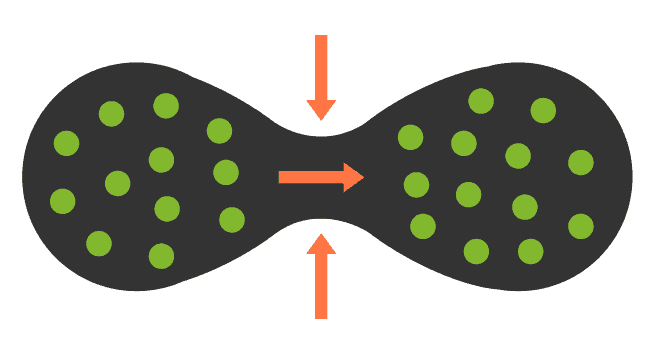
Network overload
Information travels across multiple devices and links. If one of these points is under full capacity, there will be a waiting queue in which the information will go through more slowly, becoming discarded after a certain time. The difference with bottlenecks is that it does not imply a single bottleneck, but it can be a general problem.
WiFi interference
It is normal for Wi-Fi networks to suffer, in a timely manner, packet loss. These types of wireless communications are affected by often uncontrollable elements, such as interference or “noise” in the wireless network, proximity to other wireless devices, distance, physical elements (walls), etc.
Software Errors
Software that makes network devices work properly can present certain errors or bugs.
As in all software development, it is common for updates to appear to solve possible problems that may exist, so it is advisable to keep the software of your devices updated in order to avoid possible bugs that generate an incorrect operation of the features of your machines.
Packet loss monitoring
If you are experiencing any of these problems you must identify the cause, starting with packet loss monitoring. With Pandora FMS and the help of the plugin packet_loss.sh you can get all the information to find out the necessary information and be able to monitor packet loss.
The operation consists of sending a network check (ping) to a remote computer, which can be an IP address, a host name or a website, and checking whether there is any packet loss in the information sent.
When deploying packet loss monitoring you will see in Pandora FMS console a single module with the information the plugin has been collecting, seeing whether there are times of the day when these packet losses take place repeatedly.
In the following graph we analyze the packet loss of a Wifi Access point from our office. As it can be seen, there is hardly any packet loss usually, nor is there a repetitive trend. However, a period of several hours in which there was a total packet loss can be noticed. Based on this information, we could try to find out the cause:
 Now we analyze the packet loss graph from the output to the Internet. Processing data you see that there’s a constant packet loss, but the values are low, there are no high peaks that could indicate other kinds of problems:
Now we analyze the packet loss graph from the output to the Internet. Processing data you see that there’s a constant packet loss, but the values are low, there are no high peaks that could indicate other kinds of problems:
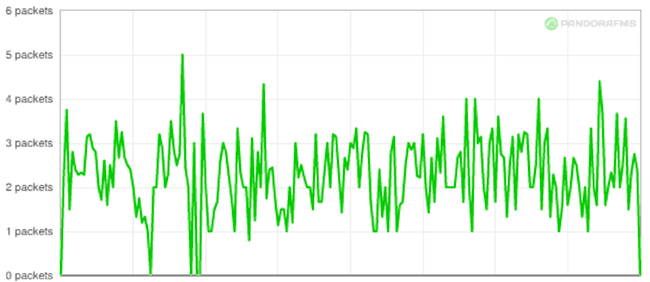
Once you know whether this loss exists you may begin to split hairs and locate the cause of the problem, looking for coherent solutions.
A good way to compare the information is, to parallelly monitor packet loss and latency times. With these two data you may establish a correlation, since normally higher latency times will match packet loss intervals.
In the following graphs you may see the correlation between latency seconds (graph 1) and packet loss (graph 2):
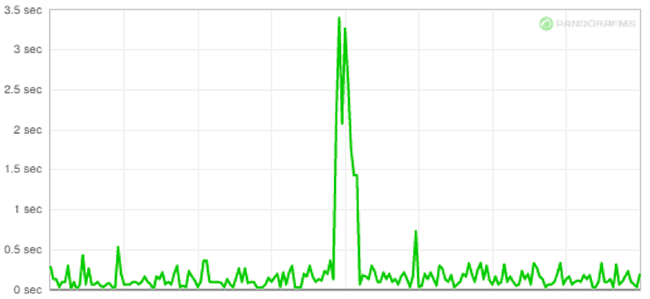
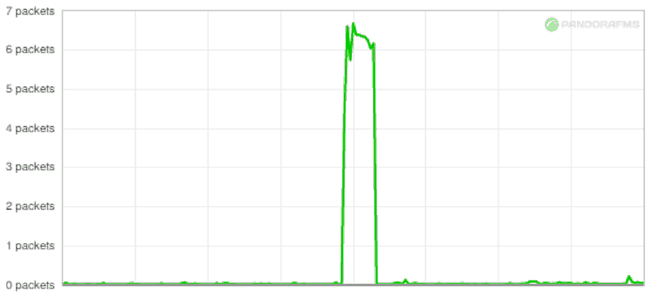
If you’re interested in learning more about response and latency checks you may check out this video:
All this information can be reflected in reports that combine graph display with the actual data obtained through monitoring:
All this information can be presented in reports that combine graphs with data obtained through monitoring:
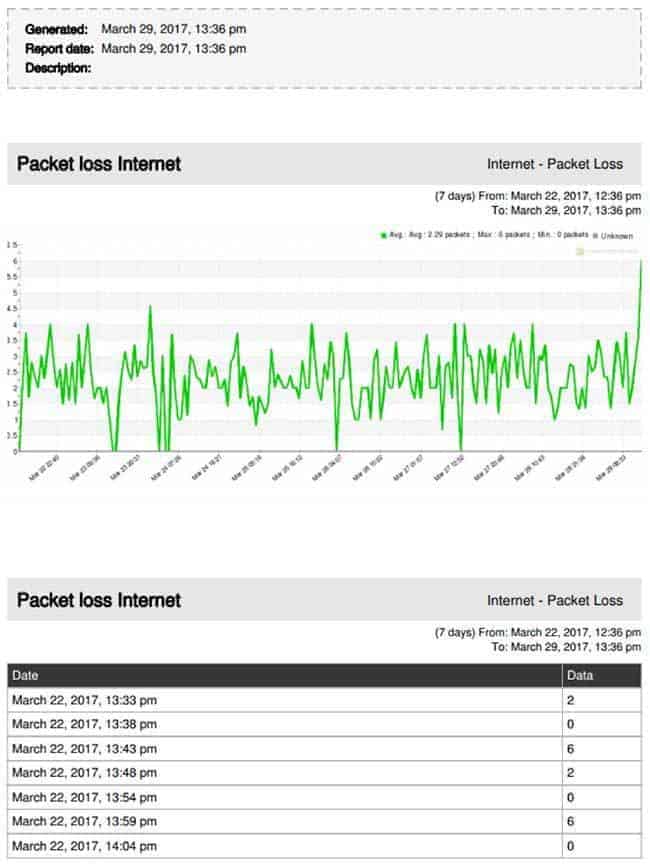
Solutions to Packet Loss
There is no universal solution to this problem, since, as we have mentioned, it may be due to a number of factors. But here we suggest some of the basic checks we need to do to start ruling out causes and potentially solving problems.
Checking out connections
Check for damaged or incorrectly connected cables or ports.
Restarting the router and computers
A basic step to perform in the face of a multitude of computer-related problems.
Using wired connection
If possible, a wired connection will in most cases ensure higher quality of communications and consequent packet loss reduction.
Updating network software
Given the possible existence of bugs in the software of both your operating system and your network devices, which causes a malfunction of some feature, it is always recommended to update to the latest versions.
It is important to clarify that if you diagnosed that the packet loss takes place from different computers, you will not solve anything by updating their operating systems, since the problem will almost certainly not be on the computers themselves.
Replace defective hardware
If you diagnosed that the problem is in one of your network hardware, you may have no choice but to replace it with a higher performance one.
Also…
To finish off, remember Pandora FMS is a flexible monitoring system, capable of monitoring devices, infrastructures, applications, services and business processes.
You may take a look at network monitoring in Pandora FMS in the following video:
Would you like to find out more about what Pandora FMS can offer you? Learn more here.
Or if you have to monitor more than 100 devices, you can also enjoy a Pandora FMS FREE 30-DAY TRIAL. Get it here.
Do not hesitate to ask us any questions. The team behind Pandora FMS will be happy to assist you!
Pandora FMS’s editorial team is made up of a group of writers and IT professionals with one thing in common: their passion for computer system monitoring. Pandora FMS’s editorial team is made up of a group of writers and IT professionals with one thing in common: their passion for computer system monitoring.
















